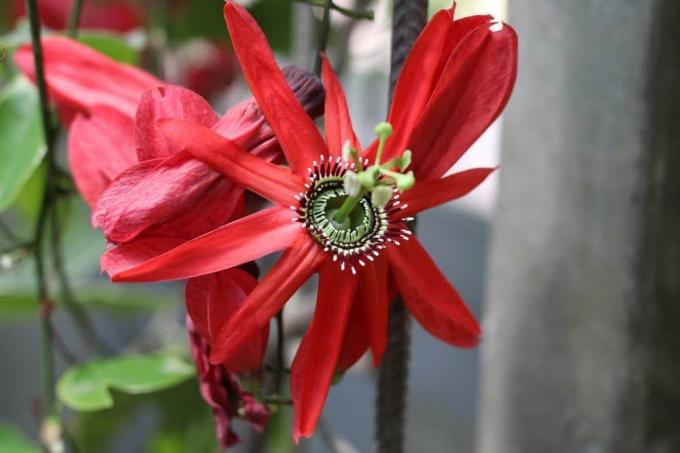
table of contents
- Characteristics
- Location
- Substrate
- Repot
- care
- to water
- Fertilize
- Cut
- Overwinter
- Multiply
- Diseases and pests
Profile and care information open +conclude -
- Flower color
- Red White
- Location
- Partial shade, sunny
- Heyday
- June, July, August, September, October
- Growth habit
- spreading, perennial, climber
- height
- up to 5 m long
- Soil moisture
- moderately moist, fresh
- PH value
- neutral, slightly acidic
- Limescale tolerance
- Calcium intolerant
- humus
- rich in humus
- Poisonous
- Yes
- Plant families
- Passion flower family, Passifloraceae
- Plant species
- Potted plants, climbing plants
- Garden style
- Pot garden, winter garden
Passion flowers are truly one of the most interesting tropical plants. Their unique flowers vary in shape, color, and size from species to species. Passiflora racemosa is one of the red passion flowers, also known as grapes Passion flower is known. The reason for this are the racemose inflorescences, which are reminiscent of grape blossoms before flowering. There can be about 30 flowers on one inflorescence. Despite its beauty, the South American climbing plant is quite easy to care for.
Characteristics
- botanical name: Passiflora racemosa
- Genus: Passion flowers (Passiflora)
- belongs to the plant family of the passion flower family (Passifloraceae)
- Common names: grape passion flower, red passion flower
- evergreen climber with spreading growth
- Growth height: up to 500 cm
- Leaves: deep green, alternate leaves up to 10 cm long and 11 cm wide
- Blossom: red flowers with a diameter of 10 cm and a three-row halo in white
- Flowering period: June to October
- Origin: Brazil
- not hardy
- not lime tolerant
- Fruits inedible
- self-fruiting
- up to 30 flowers are located on a racemose inflorescence
Location
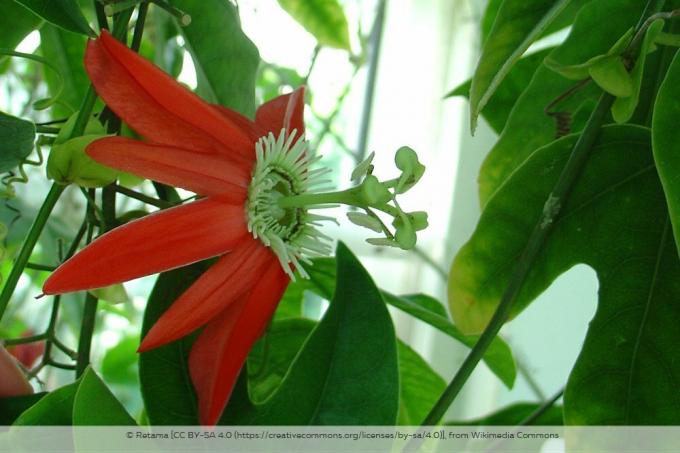
The location is an important aspect to maintain the vitality of the tropical plant. Since passion flowers cannot tolerate the cold, a warm place is necessary all year round, as damage caused by the cold can severely affect the plant. The space should correspond to the following conditions in order to be able to grant the passion flower a good place:
- Light requirement: sunny to bright
- no direct midday sun over the summer
- Temperature: 20 ° C - 25 ° C
- fresh air should be available
- protected
- no drafts
- high humidity
During the summer months you can easily place the Passiflora racemosa in the garden on a south-facing wall. Since it is a climbing plant, it can even act as a privacy screen on the balcony or terrace. Make sure that temperatures never fall below 15 ° C, because compared to other species, Passiflora racemosa does not tolerate a cooler place. If the humidity is too low, spray fresh water around the plant to increase it.
Tip: A place that is too dark is indicated by the fact that passion flowers only develop a few flowers. Grape passion flowers in particular are known for their large number of blossoms, which indicate too little light if there is not enough.
Buy preferred potted plants
Passion flowers are offered both as seeds and as young plants. When choosing, make sure that the root ball and the substrate are not too dry and that no spider mites have settled on the plant. Check the flower panicles for weakness and drought damage, as well as the shoots. If the climbing plant weakens, the cause is usually a lack of nutrients or water, but this can be remedied with a cut and appropriate care measures.
Substrate
The substrate for your red passion flower is not complicated, as the plant does not place high demands on it. Loamy and high-quality potted plant soil is ideal. In addition, one of the following drainage additives is required to prevent waterlogging:
- Clay granules
- Quartz sand
- Lava chippings
- Lava granules
The pH should be between 5.8 and 6.8.
Tip: If you cannot find any clay-containing soil, mix garden soil, alternatively potting soil based on compost, and clay powder. Don't forget the drainage agent.
Repot
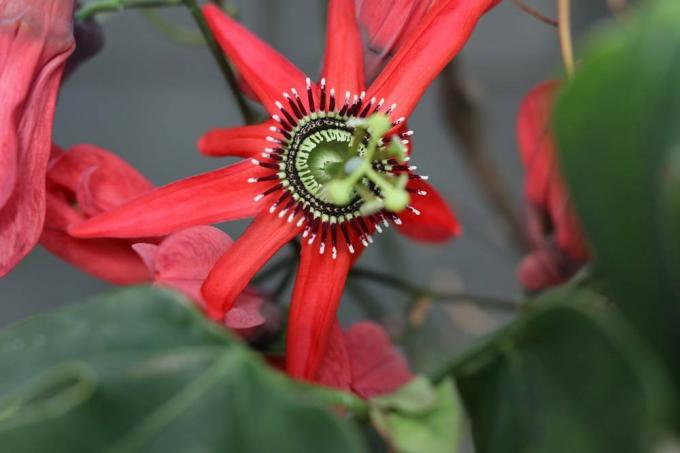
As soon as you have acquired a new specimen or your old plant becomes too large for the pot, you will need to repot. The best time to do this is from February to March. All you need is:
- fresh substrate
- Pot with drainage holes, 2 - 3 cm larger
- Climbing aid
- Gravel drainage layer
When repotting the Passiflora racemosa, proceed as follows:
- tap old pot by hand
- this loosens the earth in the bucket
- now carefully remove the plant
- free from old earth
- Check roots for rotten or parched areas
- remove with scissors
- Fill the drainage layer into a new container
- Fill halfway with substrate
- Insert the plant
- fill up with substrate
- tap again to close cavities
- press carefully
- water sufficiently
Tip: Buckets with an integrated trellis are particularly recommended. However, you should never choose pots with a larger circumference of 30 centimeters, as the plants like to be more compact and otherwise bloom rotten.
care
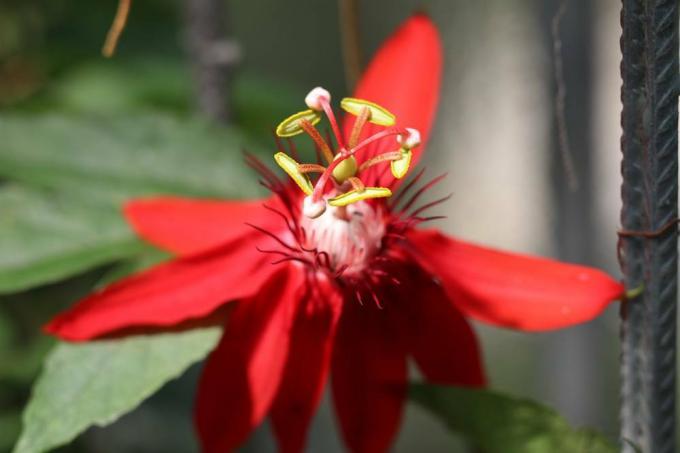
The care of the grape passionflower is very easy, as long as the location and the water additions are correct. A particularly important aspect of the maintenance measures is the winter quarters, as the Passiflora is extremely sensitive to the cold.
to water
Passiflora racemosa are watered all year round. Make sure that the substrate is always slightly damp, but that there is no waterlogging, which is particularly important in summer. Use the finger test for this. Simply pour away excess water in the coaster after 20 minutes. Pour with low-lime water:
- Rainwater
- distilled water
- stale water
Never let the substrate dry out!
Fertilize
Use a liquid potted plant fertilizer for fertilization and apply it weekly from April to October via the irrigation water.
Cut
A cut of the red passion flower is not required. As one of the few Passiflora species, it forms flowers on old wood itself and does not need any incentive to sprout. If the plant becomes too tall or wide or the climbing support overgrows, use disinfected secateurs and shorten the relevant areas between April and June.
Overwinter
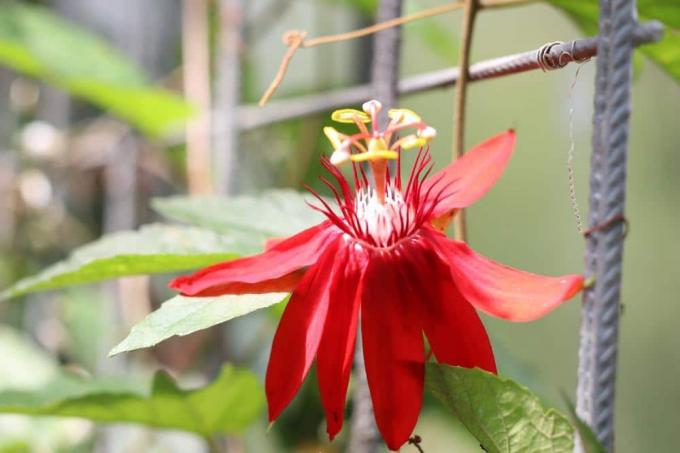
Care does not change over the winter. The only thing to keep in mind is a slightly cooler temperature of 15 ° C. You also have to water a little less. You should also protect the plant from cold drafts and pay even more attention to the humidity. If you have only little sunlight available over the winter, you should think about purchasing a plant lamp.
Multiply
The passion flower is particularly easily reproduced using cuttings from the head. To do this, remove a fresh shoot and apply some root hormone to the cut. Now place it in a growing container with the same substrate and ensure a temperature of at least 20 ° C. Sooner or later, depending on the amount of sunlight, the cuttings will develop roots. The best thing is that it reproduces all year round, as Passiflora racemosa is very robust and vigorous.
Tip: If you are lucky, your passion flower will develop seeds that you can sow in nutrient-poor soil and germinate after two to four weeks at 25 ° C to 28 ° C. You should always keep the soil moist.
Diseases and pests
Despite its sensitivity to cold and drought, Passiflora racemosa is resistant to pests and diseases. No typical diseases are known, but spider mite infestation can occur over the summer months. This is only the case if other plants in the vicinity are infested and the passiflora is too dry. As described above, the humidity in particular must not be too low. Since classic home remedies passion flowers are too aggressive, ready-made remedies based on acaricides should be used. You should also increase the humidity and place infected specimens away from healthy plants.



